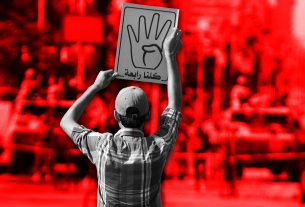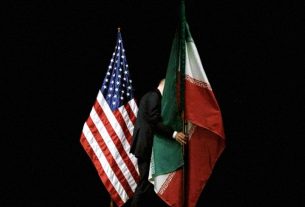Fri 08 January 2021:
The Middle East is going through a dangerous transitional phase, in which more than one arena may explode at any moment, from Syria to Lebanon, Israel, Palestine, Iraq and Yemen. They are all open spaces that Iran controls either directly or through its proxies, in their political, economic and demographic composition, as well as their social fabric.
Tehran is waiting for US President-elect Joe Biden to enter the White House and give them some relief after Donald Trump’s economic blockade and sanctions, especially over the past year. The US dealt the Iranian leadership two major blows by assassinating the commander of the Quds Force in the Islamic Revolutionary Guard Corps, General Qasem Soleimani, and the father of the Iranian nuclear programme, Mohsen Fakhrizadeh.
Soleimani travelled far and wide across the Arab world, moving his multinational militias to export the Khomeinist revolution. A US drone strike killed him at Baghdad International Airport. Fakhrizadeh was killed in broad daylight in the heart of Tehran, sending a strong warning to the Iranian government.
The Iranians will not be rid of Trump’s evil until he actually leaves the White House, as he is ready to launch a military strike against them, even on his last day in office. The US President set his sights from the moment of his election to limit Tehran’s regional influence, before any other regional or international goal.
At the time, Trump announced that he was not interested in bringing down Bashar Al-Assad, but rather wanted to remove Iranian forces from Syria. However, he kept US troops in northern Syria, and a few days ago he reinforced them on the Syrian-Iraqi border, at Al-Tanf, which Iran seeks to establish as a strategic route to the Mediterranean and Beirut. The use of sanctions throughout this time has turned into painful political, economic, financial and military pressure across the region from Iraq to Syria to Lebanon.
Despite Trump having just two weeks left in the White House, yesterday the US Treasury imposed new sanctions targeting the Central Bank of Syria. It hit entities and individuals, including Assad’s wife who, as head of the Syria Trust for Development, became a member of the Evaluation Body of UNESCO’s Intergovernmental Committee for the Safeguarding of Intangible Cultural Heritage. This step was an attempt to legitimise the regime in international forums.
Syria has turned into a confrontation zone between Tehran and Washington, as well as Moscow, Ankara and Tel Aviv, in anticipation of the approach that soon-to-be President Biden will adopt. He has already announced positions against the Syrian regime, as well as Turkey and President Recep Tayyip Erdogan. Assad is now seeking to beat such developments and use his allies to guarantee himself a fourth term of office since 2000 in the next presidential election. This is an option for Iran and a fait accompli for Russia, which is still betting on negotiating with the US and reining in Turkey’s activity in northern Syria. This, of course, contradicts UN Resolution 2254, which includes a process for the transition of power in Syria, followed by the holding of free and fair elections under the supervision of the UN. In other words, Assad’s departure from the political scene. However, is it possible to hold an election with any credibility in a country occupied by five armies?
Assad lives in denial and acts as if he is still has power across Syria. The reality is that he is a prisoner of those who protect him and keep him on the throne in Al-Muhajireen Palace in Damascus. He has no authority over the south or the north of “his” country.
Today, Assad is looking for legitimacy through the ballot box, not through pledges or referendums, as was the custom in Baathist Syria, and under all such tyrannical regimes in the Arab region for decades. He is now struggling to prepare his presidential campaign.
This is based on three factors: security, where he is reconfiguring the military, parts of which are loyal to Iran and others to Russia, and has appointed a new commander for the Special Forces; the media, which he is trying to win over by using foreign journalists, especially Lebanese affiliated with the axis of resistance, in an attempt to dispel suspicions of their subordination to the regime; and his fear that the presidential election will make him president over little more than a rump Syria.
There are a number of areas of influence outside his control, such as the Autonomous Administration areas, the north under Turkish control, and the south. He sent his new foreign minister, Faisal Al-Miqdad, to Moscow to convince the Russians to help prevent elections in north-west Syria and Idlib, as well as in the south, and in the Kurdish areas controlled and run by the Syrian Democratic Forces (SDF). It seems that the regime is trying to tempt the Russians into choosing the opposition candidate to compete against Assad for the presidency, as a prelude to him possibly becoming the president in the post-Assad era.
However, Assad’s dreams will remain illusory, or turn into nightmares, because Russian President Vladimir Putin’s calculations are different; he does not have the luxury of being able to waste time given Moscow’s intervention in the Middle East, which has been costly politically, militarily, financially and strategically. When Putin decided to intervene five years ago to save Assad, he was not betting on him or his crumbling regime. He saw it as an opportunity to restore the role of the former Soviet Union and put his foot in a strategic country giving himself influence in the region. This was while US President Barak Obama was hesitant and withdrew from any role in Syria, preferring to sign the nuclear agreement with Iran in the summer of 2015, two months before Russia’s military intervention.
Then Trump turned things upside down, taking the nuclear issue back to square one and imposing a new reality not only on Putin, but also on his successor in the White House. Today, Iran is besieged by sanctions and its economy is bleeding, while Iraq’s government is under the US umbrella, and Lebanon, where Iranian proxy Hezbollah is based, is paralysed without a government and on the verge of collapse.
The Assad regime, meanwhile, is besieged by sanctions and boycott and accountability laws like America’s Caesar and Magnitsky Acts, which respectively impose sanctions on parties and people who deal with the regime or provide it with any assistance, and authorise the US government to impose sanctions on human rights violators. As for sovereignty, in terms of land in Syria this is distributed between Russia, America, Turkey and Iran; in terms of air space, it belongs to Israel. The part ruled by Assad does not balance the weight of the next round of negotiations between Moscow and Washington, which wants to add Iran to the equation.
This article first appeared in Arabic in Al-Araby Al-Jadeed on 6 January 2020.
The statements, views and opinions expressed in this column are solely those of the author and do not necessarily represent those of Independent Press.
We welcome all pitches and submissions to Independent Press Opinion – please send them via email, to admin@independentpress.cc
FOLLOW INDEPENDENT PRESS:
TWITTER (CLICK HERE)
https://twitter.com/IpIndependent
FACEBOOK (CLICK HERE)
https://web.facebook.com/ipindependent
Think your friends would be interested? Share this story!





